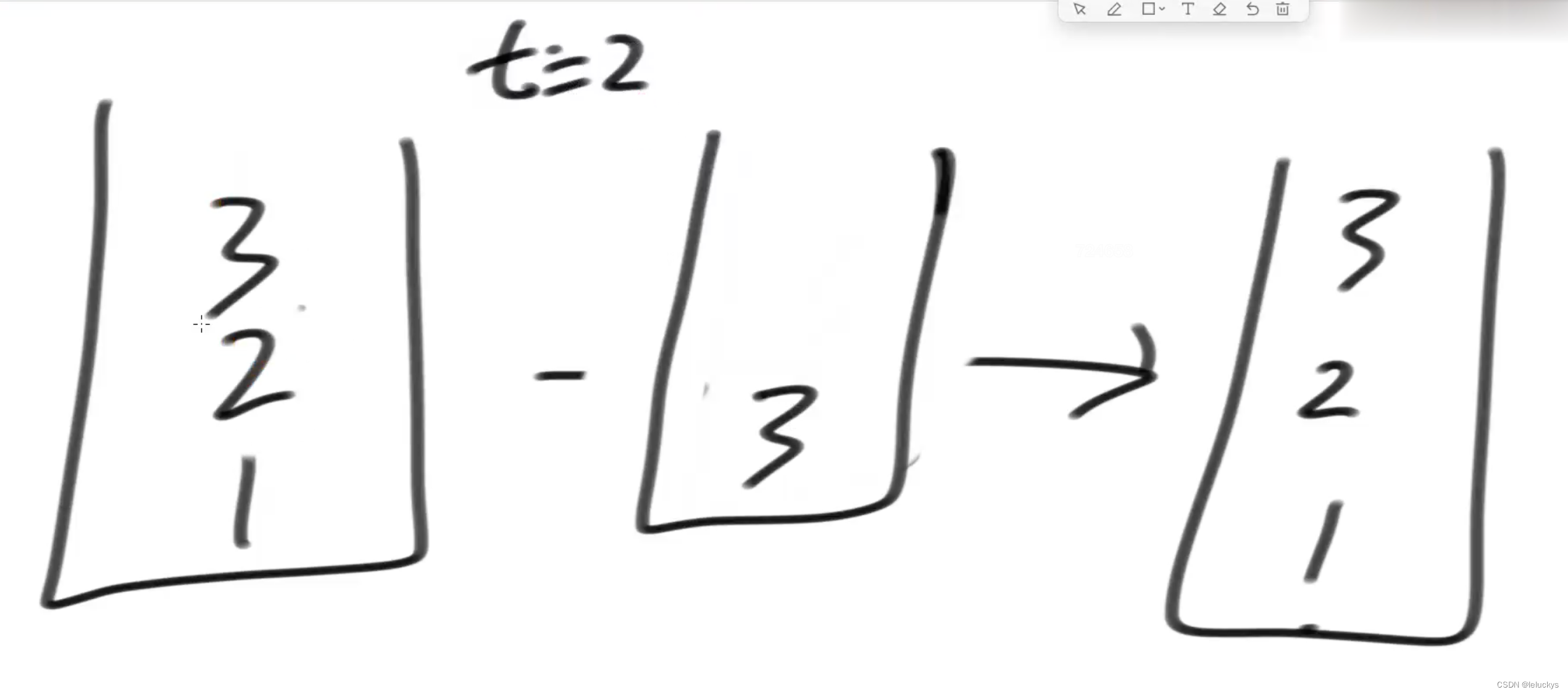一 暴力递归就是尝试
1,把问题转化为规模缩小了的同类问题的子问题
2,有明确的不需要继续进行递归的条件(base case)
3,有当得到了子问题的结果之后的决策过程
4,不记录每一个子问题的解
二 打印n层汉诺塔从最左边移动到最右边的全部过程
2.1 描述
打印n层汉诺塔从最左边移动到最右边的全部过程
2.1 分析
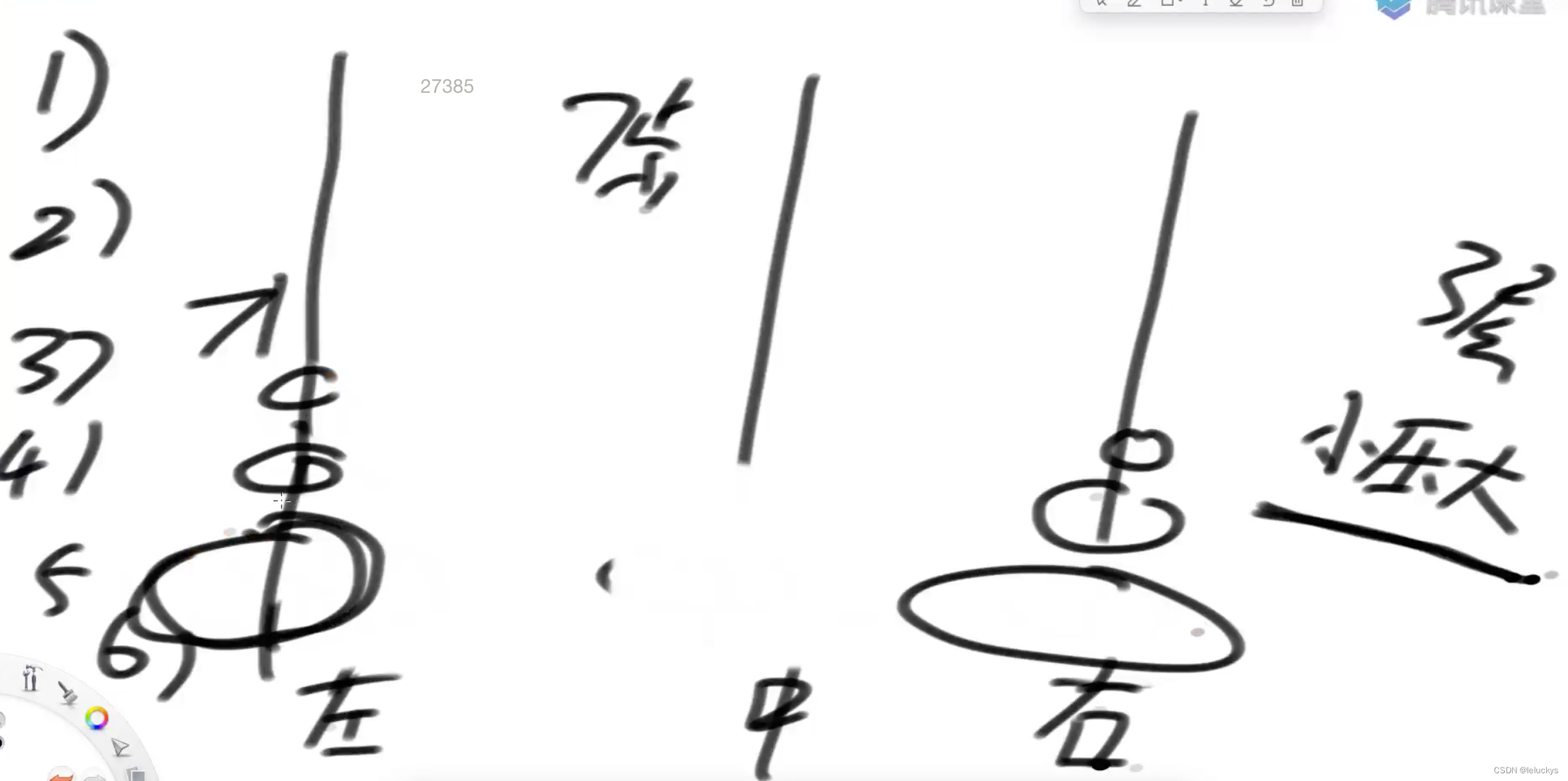
第一步
从以下三个步骤来进行移动,补齐相应的函数

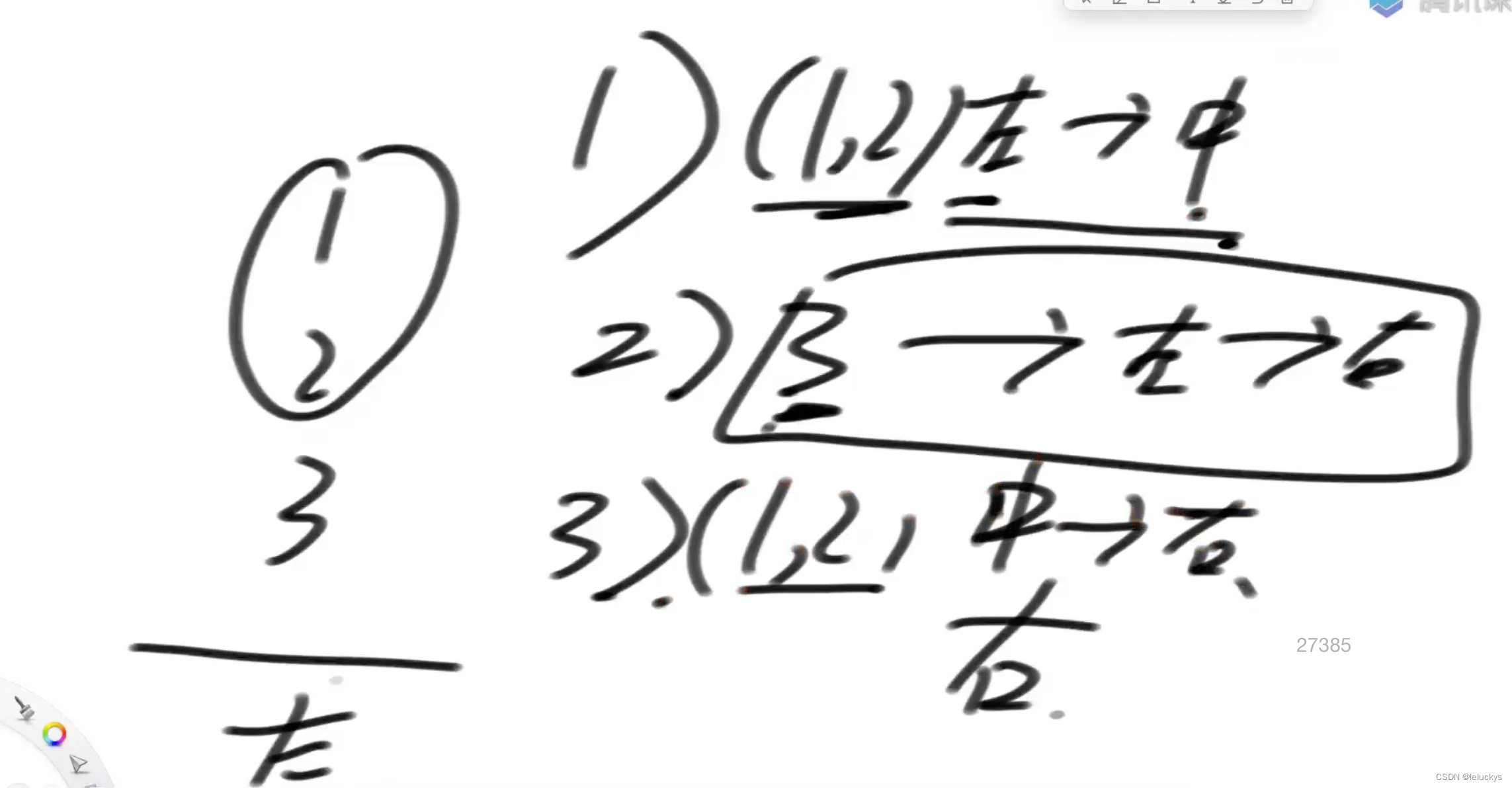
第二步
leftToMid(n - 1);

其实就是定义六个过程
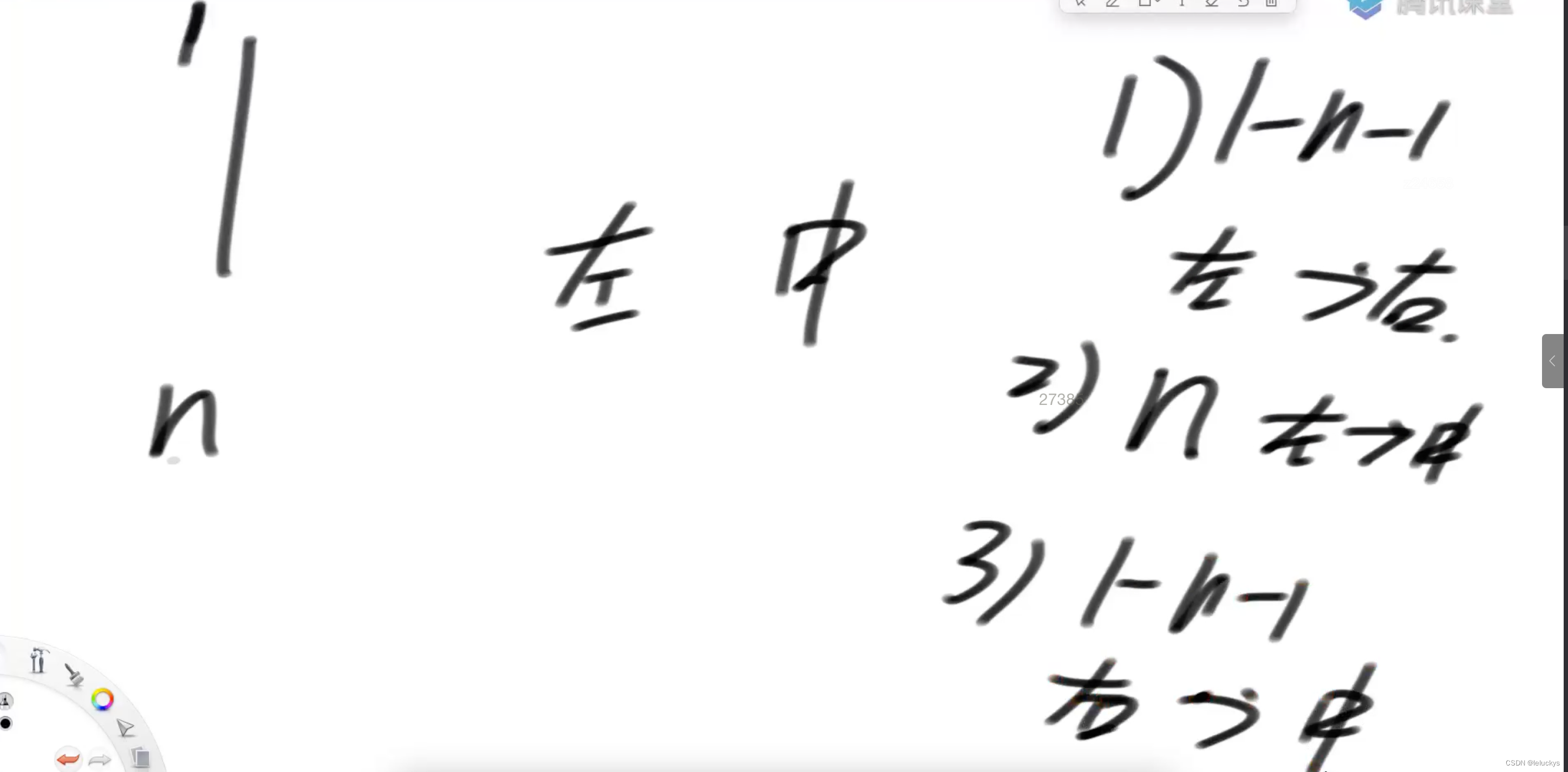
总结
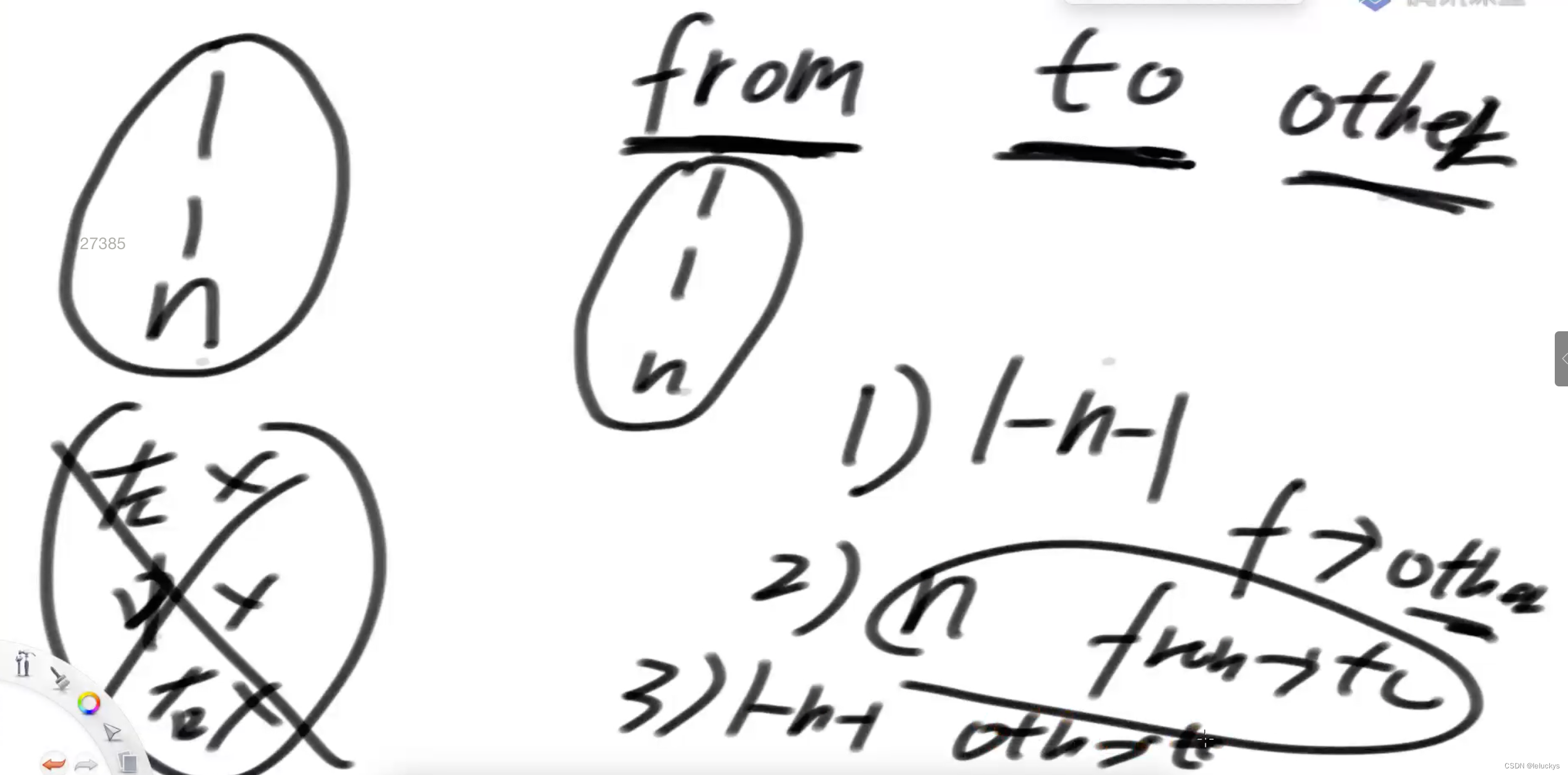
2.3代码
package class17;
import java.util.HashSet;
import java.util.Stack;
public class Code02_Hanoi {
public static void hanoi1(int n) {
leftToRight(n);
}
// 请把1~N层圆盘 从左 -> 右
public static void leftToRight(int n) {
if (n == 1) { // base case
System.out.println("Move 1 from left to right");
return;
}
leftToMid(n - 1);
System.out.println("Move " + n + " from left to right");
midToRight(n - 1);
}
// 请把1~N层圆盘 从左 -> 中
public static void leftToMid(int n) {
if (n == 1) {
System.out.println("Move 1 from left to mid");
return;
}
leftToRight(n - 1);
System.out.println("Move " + n + " from left to mid");
rightToMid(n - 1);
}
public static void rightToMid(int n) {
if (n == 1) {
System.out.println("Move 1 from right to mid");
return;
}
rightToLeft(n - 1);
System.out.println("Move " + n + " from right to mid");
leftToMid(n - 1);
}
public static void midToRight(int n) {
if (n == 1) {
System.out.println("Move 1 from mid to right");
return;
}
midToLeft(n - 1);
System.out.println("Move " + n + " from mid to right");
leftToRight(n - 1);
}
public static void midToLeft(int n) {
if (n == 1) {
System.out.println("Move 1 from mid to left");
return;
}
midToRight(n - 1);
System.out.println("Move " + n + " from mid to left");
rightToLeft(n - 1);
}
public static void rightToLeft(int n) {
if (n == 1) {
System.out.println("Move 1 from right to left");
return;
}
rightToMid(n - 1);
System.out.println("Move " + n + " from right to left");
midToLeft(n - 1);
}
public static void hanoi2(int n) {
if (n > 0) {
func(n, "left", "right", "mid");
}
}
public static void func(int N, String from, String to, String other) {
if (N == 1) { // base
System.out.println("Move 1 from " + from + " to " + to);
} else {
func(N - 1, from, other, to);
System.out.println("Move " + N + " from " + from + " to " + to);
func(N - 1, other, to, from);
}
}
public static class Record {
public int level;
public String from;
public String to;
public String other;
public Record(int l, String f, String t, String o) {
level = l;
from = f;
to = t;
other = o;
}
}
// 之前的迭代版本,很多同学表示看不懂
// 所以我换了一个更容易理解的版本
// 看注释吧!好懂!
// 你把汉诺塔问题想象成二叉树
// 比如当前还剩i层,其实打印这个过程就是:
// 1) 去打印第一部分 -> 左子树
// 2) 打印当前的动作 -> 当前节点
// 3) 去打印第二部分 -> 右子树
// 那么你只需要记录每一个任务 : 有没有加入过左子树的任务
// 就可以完成迭代对递归的替代了
public static void hanoi3(int N) {
if (N < 1) {
return;
}
// 每一个记录进栈
Stack<Record> stack = new Stack<>();
// 记录每一个记录有没有加入过左子树的任务
HashSet<Record> finishLeft = new HashSet<>();
// 初始的任务,认为是种子
stack.add(new Record(N, "left", "right", "mid"));
while (!stack.isEmpty()) {
// 弹出当前任务
Record cur = stack.pop();
if (cur.level == 1) {
// 如果层数只剩1了
// 直接打印
System.out.println("Move 1 from " + cur.from + " to " + cur.to);
} else {
// 如果不只1层
if (!finishLeft.contains(cur)) {
// 如果当前任务没有加入过左子树的任务
// 现在就要加入了!
// 把当前的任务重新压回去,因为还不到打印的时候
// 再加入左子树任务!
finishLeft.add(cur);
stack.push(cur);
stack.push(new Record(cur.level - 1, cur.from, cur.other, cur.to));
} else {
// 如果当前任务加入过左子树的任务
// 说明此时已经是第二次弹出了!
// 说明左子树的所有打印任务都完成了
// 当前可以打印了!
// 然后加入右子树的任务
// 当前的任务可以永远的丢弃了!
// 因为完成了左子树、打印了自己、加入了右子树
// 再也不用回到这个任务了
System.out.println("Move " + cur.level + " from " + cur.from + " to " + cur.to);
stack.push(new Record(cur.level - 1, cur.other, cur.to, cur.from));
}
}
}
}
public static void main(String[] args) {
int n = 3;
hanoi1(n);
System.out.println("============");
hanoi2(n);
System.out.println("============");
hanoi3(n);
}
}
2.4 启发 将上面的六个过程进行抽象话 增加参数如下
上面的六个过程都可以用 from to other 来代替
第一步
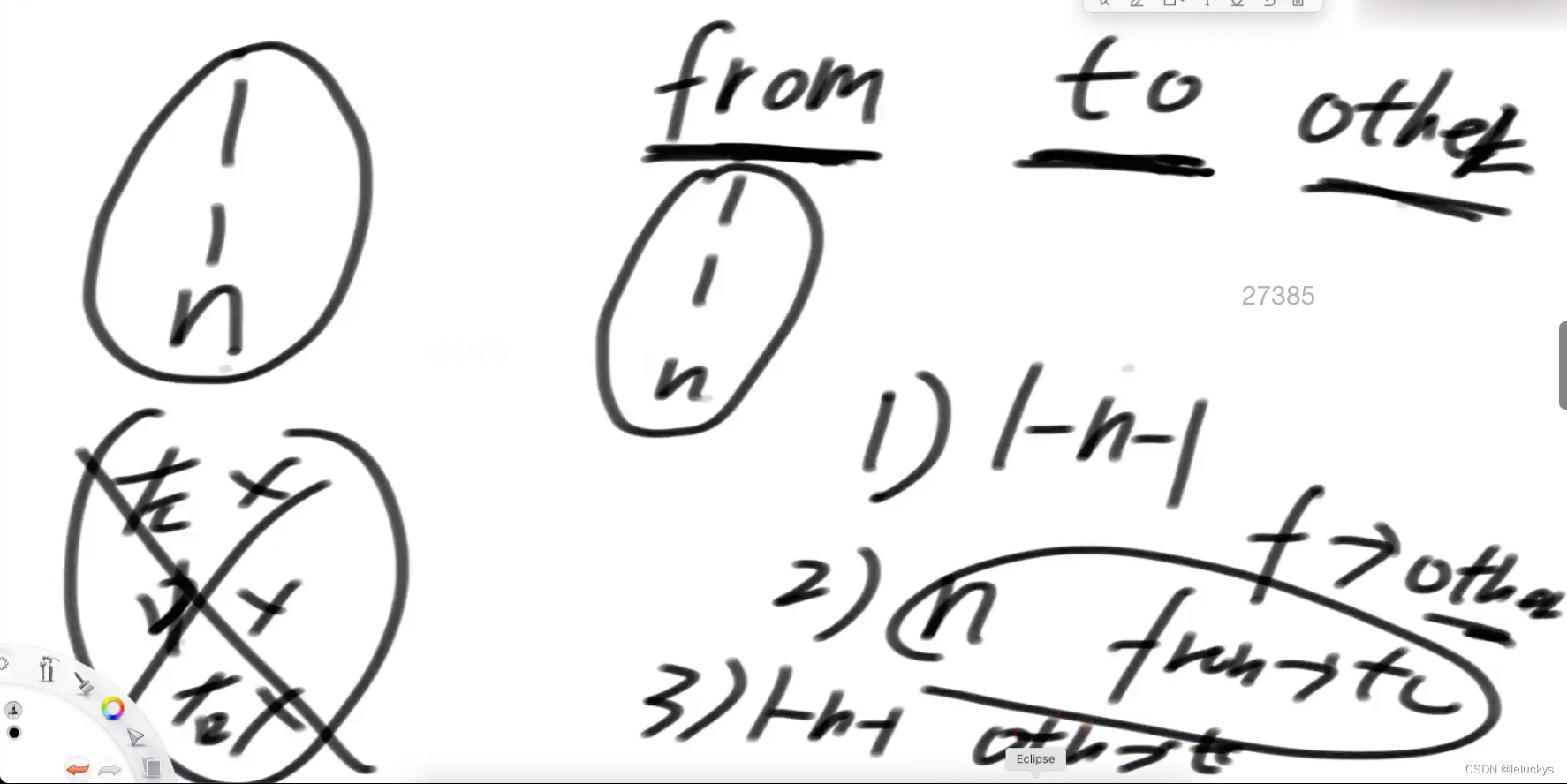 第二步
第二步
public static void hanoi2(int n) {
if (n > 0) {
func(n, "left", "right", "mid");
}
}
//1-N 在 from
// 去:to
// 宁一个 other
public static void func(int N, String from, String to, String other) {
if (N == 1) { // base
System.out.println("Move 1 from " + from + " to " + to);
} else {
func(N - 1, from, other, to);
System.out.println("Move " + N + " from " + from + " to " + to);
func(N - 1, other, to, from);
}
}三 打印一个字符串的全部子序列(可以不连续的)
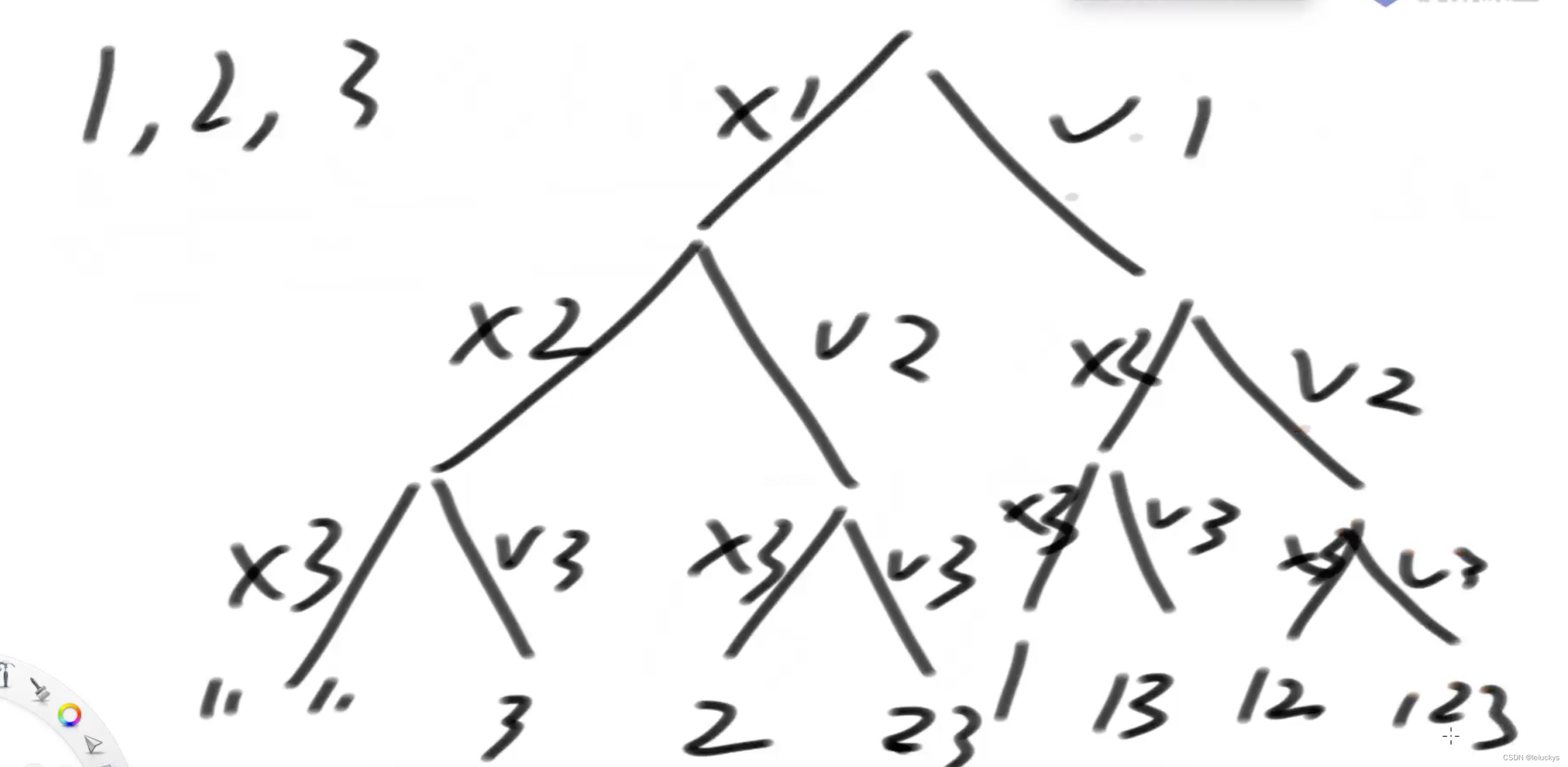
3.2 分析
3.3 代码
package class17;
import java.util.ArrayList;
import java.util.HashSet;
import java.util.List;
public class Code03_PrintAllSubsquences {
// s -> "abc" ->
public static List<String> subs(String s) {
char[] str = s.toCharArray();
String path = "";
List<String> ans = new ArrayList<>();
process1(str, 0, ans, path);
return ans;
}
// str 固定参数
// 来到了str[index]字符,index是位置
// str[0..index-1]已经走过了!之前的决定,都在path上
// 之前的决定已经不能改变了,就是path
// str[index....]还能决定,之前已经确定,而后面还能自由选择的话,
// 把所有生成的子序列,放入到ans里去
public static void process1(char[] str, int index, List<String> ans, String path) {
if (index == str.length) {
ans.add(path);
return;
}
// 没有要index位置的字符
process1(str, index + 1, ans, path);
// 要了index位置的字符
process1(str, index + 1, ans, path + String.valueOf(str[index]));
}
//打印一个字符串的全部子序列,要求不要出现重复字面值的子序列
public static List<String> subsNoRepeat(String s) {
char[] str = s.toCharArray();
String path = "";
HashSet<String> set = new HashSet<>();
process2(str, 0, set, path);
List<String> ans = new ArrayList<>();
for (String cur : set) {
ans.add(cur);
}
return ans;
}
public static void process2(char[] str, int index, HashSet<String> set, String path) {
if (index == str.length) {
set.add(path);
return;
}
String no = path;
process2(str, index + 1, set, no);
String yes = path + String.valueOf(str[index]);
process2(str, index + 1, set, yes);
}
public static void main(String[] args) {
String test = "acccc";
List<String> ans1 = subs(test);
List<String> ans2 = subsNoRepeat(test);
for (String str : ans1) {
System.out.println(str);
}
System.out.println("=================");
for (String str : ans2) {
System.out.println(str);
}
System.out.println("=================");
}
}
3.4 打印一个字符串的全部子序列,要求不要出现重复字面值的子序列
public static List<String> subsNoRepeat(String s) {
char[] str = s.toCharArray();
String path = "";
HashSet<String> set = new HashSet<>();
process2(str, 0, set, path);
List<String> ans = new ArrayList<>();
for (String cur : set) {
ans.add(cur);
}
return ans;
}
public static void process2(char[] str, int index, HashSet<String> set, String path) {
if (index == str.length) {
set.add(path);
return;
}
String no = path;
process2(str, index + 1, set, no);
String yes = path + String.valueOf(str[index]);
process2(str, index + 1, set, yes);
}
四 打印一个字符串的全部排列
4.1 描述
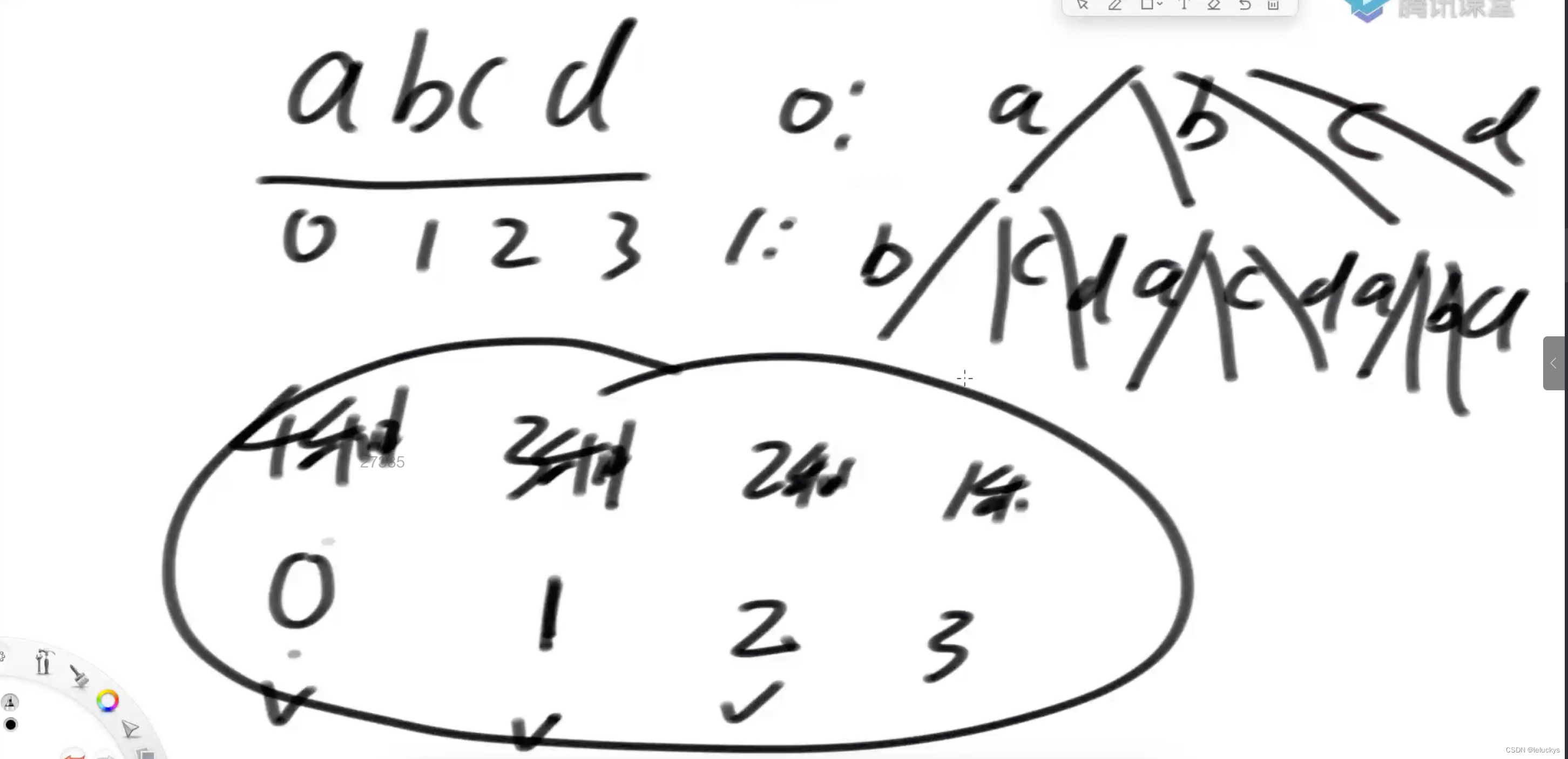
4.2 分析
for 循环里面是跑支路,每到下一个支路的时候都要将之前删除的加回来,恢复现场
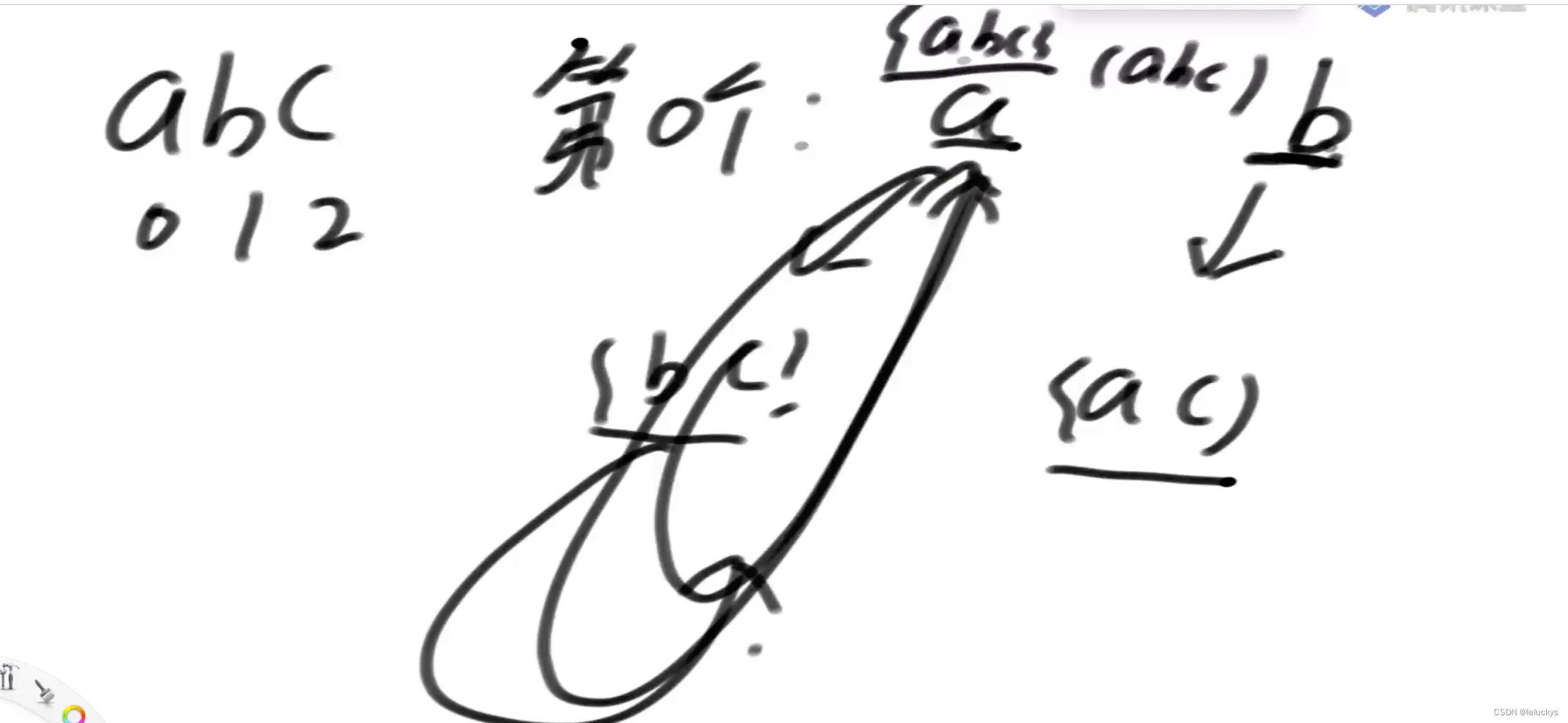
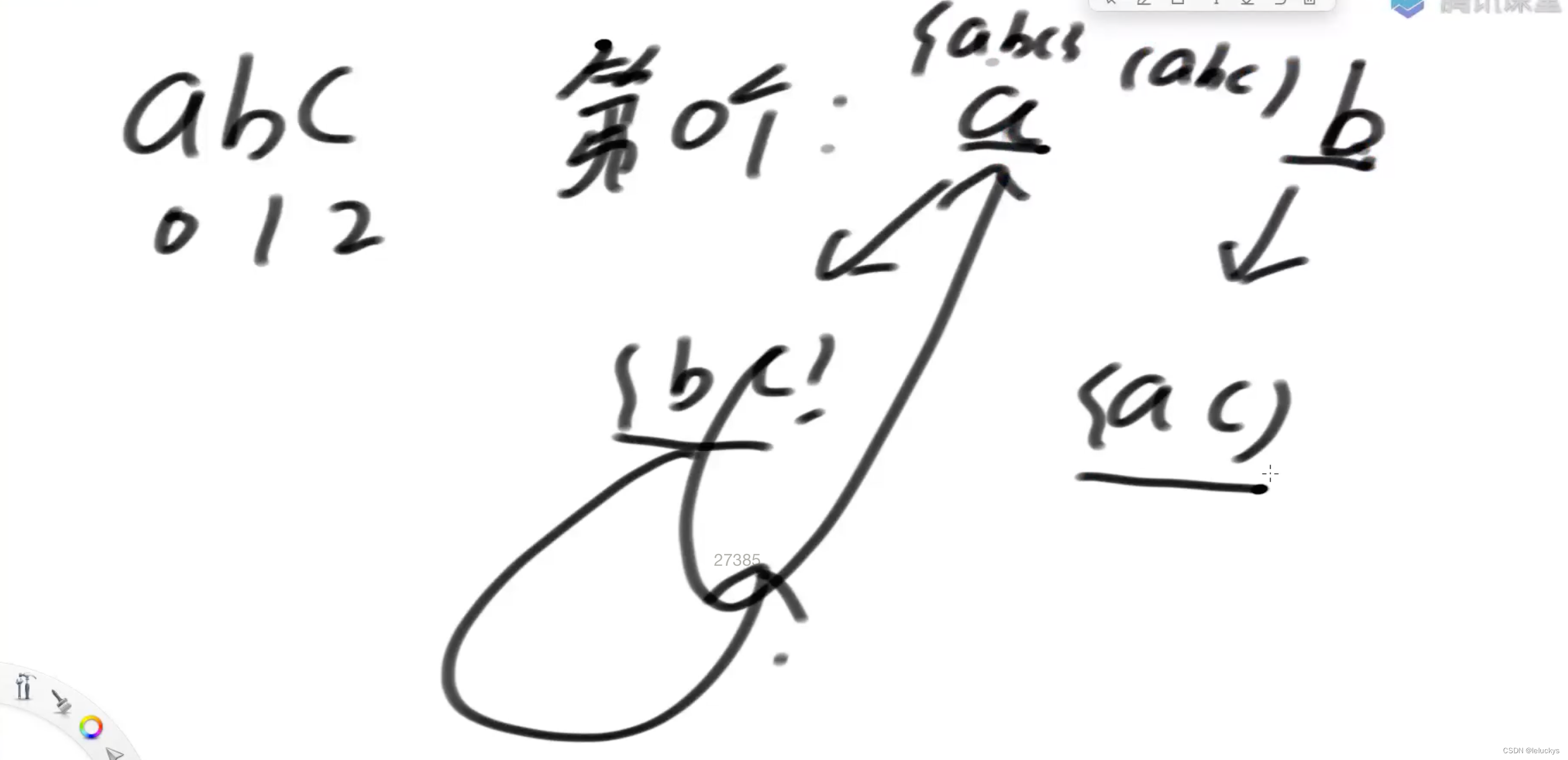 4.3 分析二
4.3 分析二
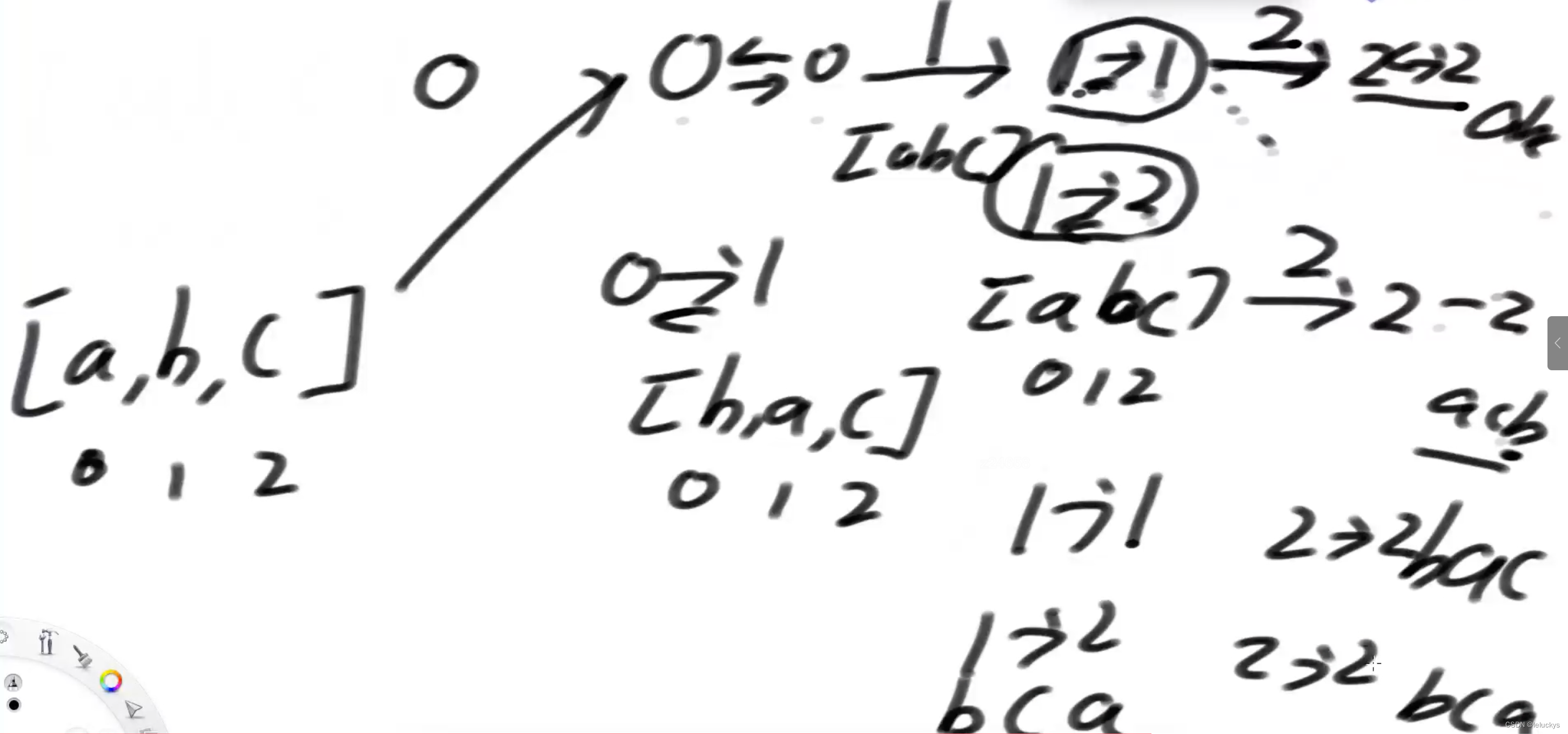
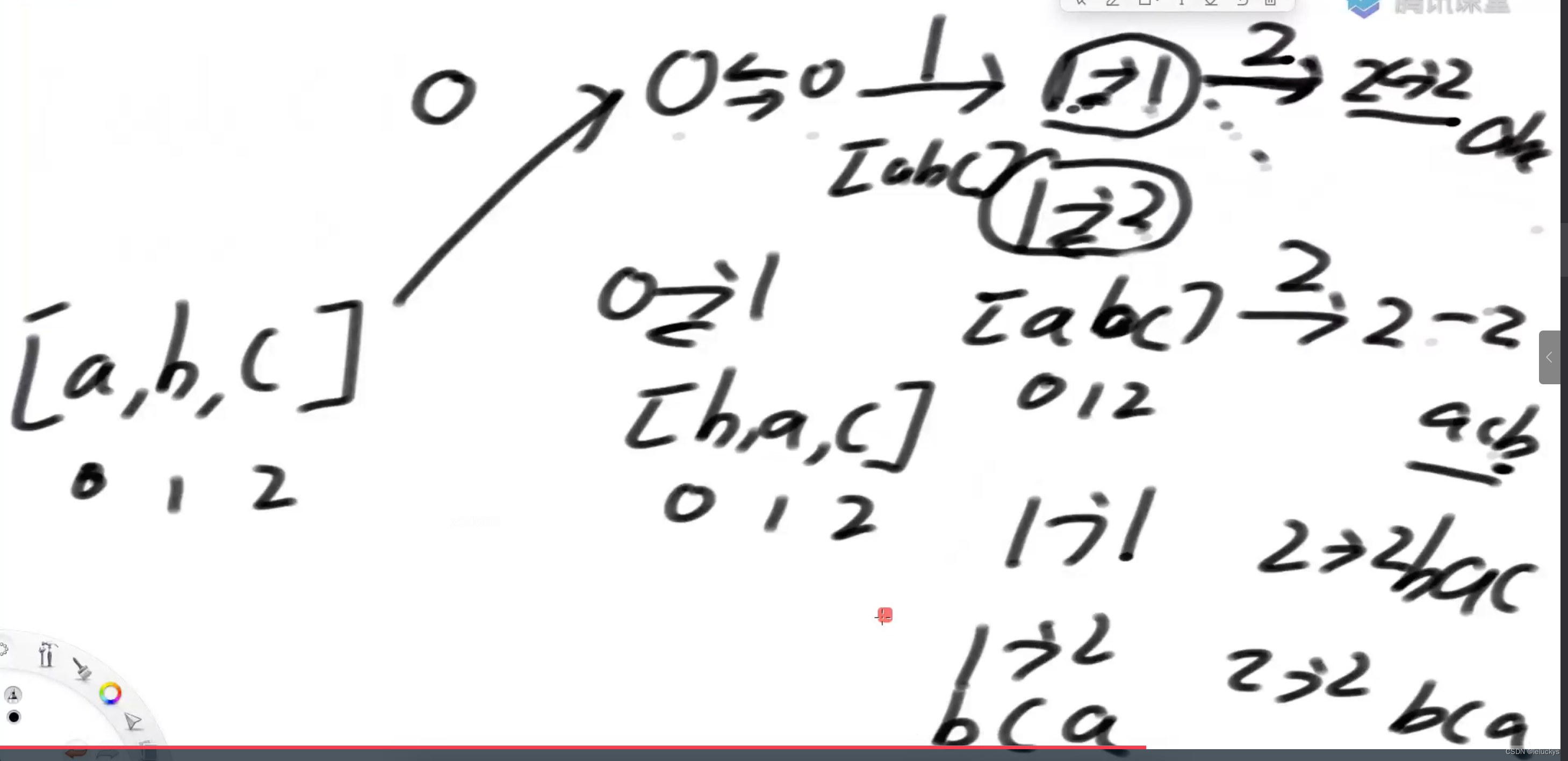
 4.4代码
4.4代码
package class17;
import java.util.ArrayList;
import java.util.List;
public class Code04_PrintAllPermutations {
public static List<String> permutation1(String s) {
List<String> ans = new ArrayList<>();
if (s == null || s.length() == 0) {
return ans;
}
char[] str = s.toCharArray();
ArrayList<Character> rest = new ArrayList<Character>();
for (char cha : str) {
rest.add(cha);
}
String path = "";
f(rest, path, ans);
return ans;
}
public static void f(ArrayList<Character> rest, String path, List<String> ans) {
if (rest.isEmpty()) {
ans.add(path);
} else {
int N = rest.size();
for (int i = 0; i < N; i++) {
char cur = rest.get(i);
rest.remove(i);
f(rest, path + cur, ans);
rest.add(i, cur);
}
}
}
public static List<String> permutation2(String s) {
List<String> ans = new ArrayList<>();
if (s == null || s.length() == 0) {
return ans;
}
char[] str = s.toCharArray();
g1(str, 0, ans);
return ans;
}
分析二交换的代码
public static void g1(char[] str, int index, List<String> ans) {
if (index == str.length) {
ans.add(String.valueOf(str));
} else {
for (int i = index; i < str.length; i++) {
swap(str, index, i);
g1(str, index + 1, ans);
swap(str, index, i);
}
}
}
public static List<String> permutation3(String s) {
List<String> ans = new ArrayList<>();
if (s == null || s.length() == 0) {
return ans;
}
char[] str = s.toCharArray();
g2(str, 0, ans);
return ans;
}
public static void g2(char[] str, int index, List<String> ans) {
if (index == str.length) {
ans.add(String.valueOf(str));
} else {
//4.4 打印一个字符串的全部排列,要求不要出现重复的排列
boolean[] visited = new boolean[256];//去除重复的
for (int i = index; i < str.length; i++) {
if (!visited[str[i]]) {
visited[str[i]] = true;
swap(str, index, i);
g2(str, index + 1, ans);
swap(str, index, i);
}
}
}
}
public static void swap(char[] chs, int i, int j) {
char tmp = chs[i];
chs[i] = chs[j];
chs[j] = tmp;
}
public static void main(String[] args) {
String s = "acc";
List<String> ans1 = permutation1(s);
for (String str : ans1) {
System.out.println(str);
}
System.out.println("=======");
List<String> ans2 = permutation2(s);
for (String str : ans2) {
System.out.println(str);
}
System.out.println("=======");
List<String> ans3 = permutation3(s);
for (String str : ans3) {
System.out.println(str);
}
}
}
4.4 打印一个字符串的全部排列,要求不要出现重复的排列
4.4.1 分析 判断每一个支路看这个字符是否试过了

4.4.2 代码
public static List<String> permutation3(String s) {
List<String> ans = new ArrayList<>();
if (s == null || s.length() == 0) {
return ans;
}
char[] str = s.toCharArray();
g2(str, 0, ans);
return ans;
}
public static void g2(char[] str, int index, List<String> ans) {
if (index == str.length) {
ans.add(String.valueOf(str));
} else {
boolean[] visited = new boolean[256];
for (int i = index; i < str.length; i++) {
if (!visited[str[i]]) {
visited[str[i]] = true;
swap(str, index, i);
g2(str, index + 1, ans);
swap(str, index, i);
}
}
}
}
五 仰望好的尝试?这个题练递归特别好
5.1 描述
给你一个栈,请你逆序这个栈,
不能申请额外的数据结构,
只能使用递归函数。 如何实现?
5.2 分析
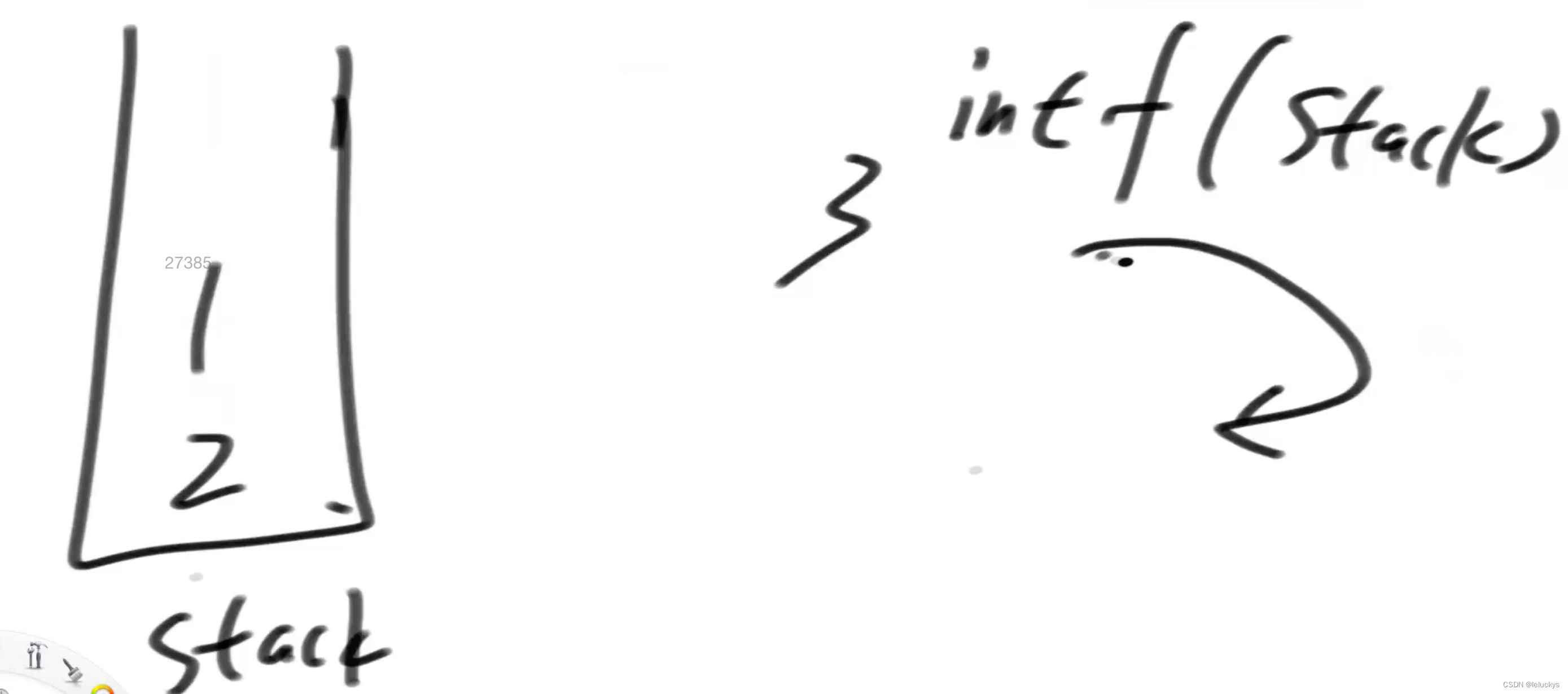
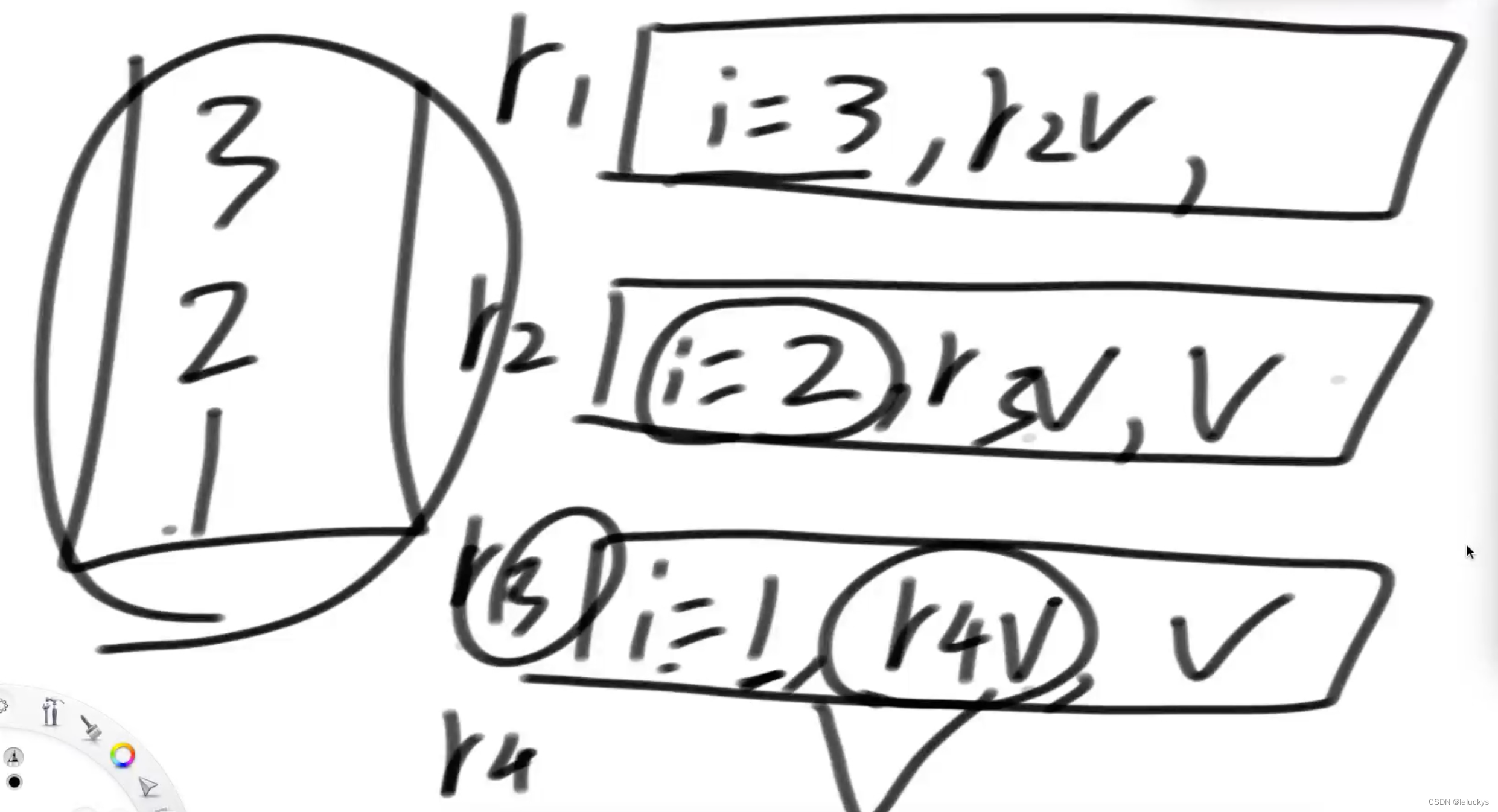
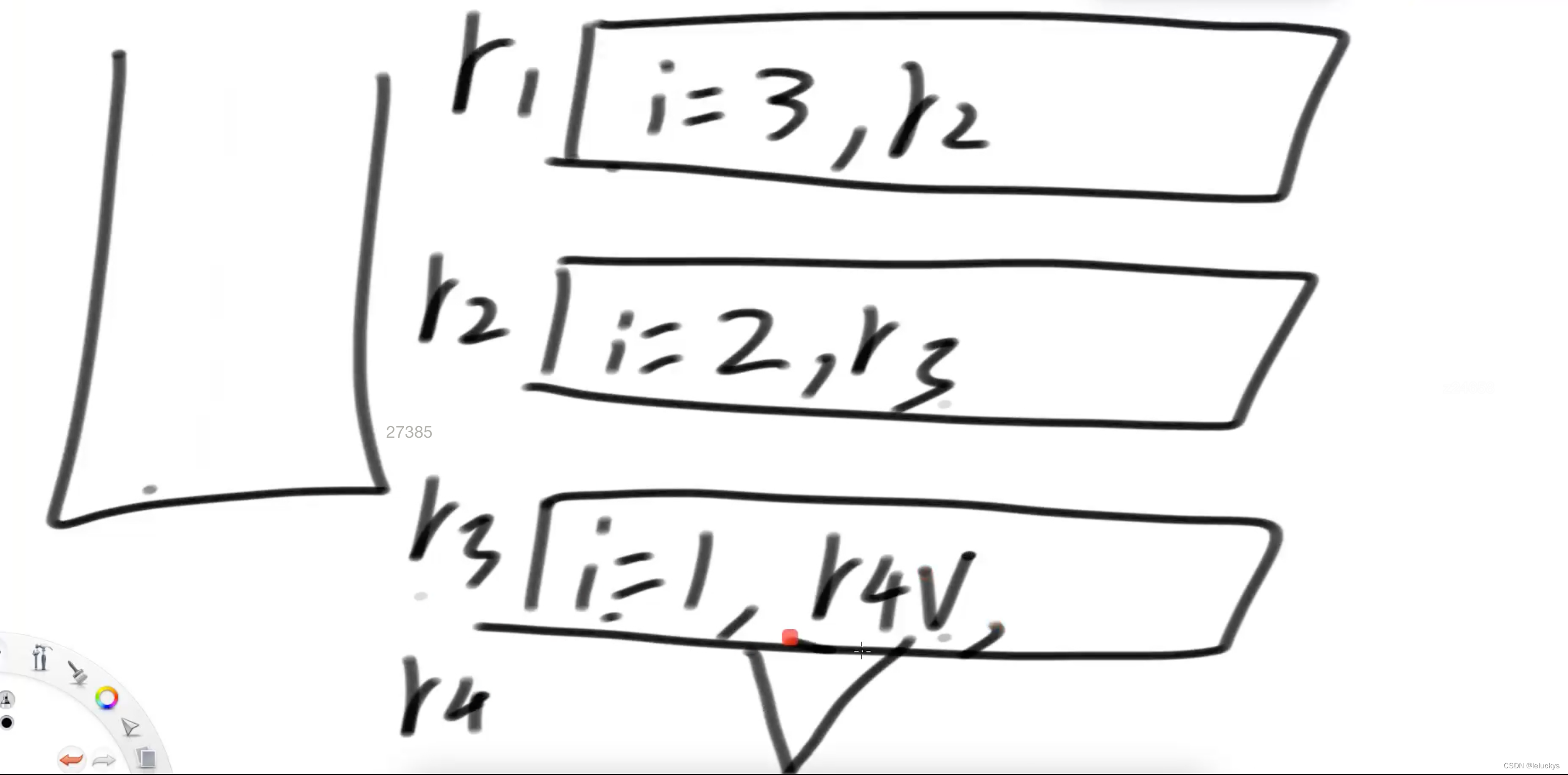
5.3 代码
package class17;
import java.util.Stack;
public class Code05_ReverseStackUsingRecursive {
public static void reverse(Stack<Integer> stack) {
if (stack.isEmpty()) {
return;
}
int i = f(stack);
reverse(stack);
stack.push(i);
}
// 栈底元素移除掉
// 上面的元素盖下来
// 返回移除掉的栈底元素
public static int f(Stack<Integer> stack) {
int result = stack.pop();
if (stack.isEmpty()) {
return result;
} else {
int last = f(stack);
stack.push(result);
return last;
}
}
public static void main(String[] args) {
Stack<Integer> test = new Stack<Integer>();
test.push(1);
test.push(2);
test.push(3);
test.push(4);
test.push(5);
reverse(test);
while (!test.isEmpty()) {
System.out.println(test.pop());
}
}
}
5.4 不用递归代码
